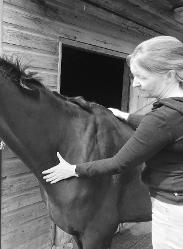Equine physiotherapy, also known as equine physical therapy or veterinary physiotherapy, is a specialised field that focuses on improving the well-being, performance, and recovery of horses through physical rehabilitation techniques. This form of therapy plays a vital role in enhancing the overall health and quality of life of horses, enabling them to perform at their best, whether they are competitive athletes, working animals, or companion animals.
As veterinary science and knowledge of equine anatomy and biomechanics advanced, so did the understanding and application of physiotherapy techniques for horses. Today, equine physiotherapy is a well-established and widely accepted practice used in most equestrian disciplines.

Equine Physiotherapy: Enhancing Equine Health and Performance
The Role of Equine Physiotherapists:
Equine physiotherapists are highly skilled professionals who work closely with veterinarians and horse owners to assess, diagnose, and treat musculoskeletal issues and injuries in horses. They play a crucial role in developing personalised rehabilitation programs to address specific conditions, promote healing, and prevent further injuries. Additionally, they provide valuable advice on exercise programs, proper training techniques, and management practices to optimize equine performance and well-being.
Common Conditions Treated with Equine Physiotherapy:
Equine physiotherapy is beneficial for a wide range of conditions, including but not limited to:
- Muscle Strains and Sprains: Horses, like any athletes, can suffer from muscle strains and sprains during training or competition. Physiotherapy helps in alleviating pain, reducing inflammation, and facilitating muscle recovery.
- Joint and Ligament Injuries: Equine physiotherapists use techniques such as therapeutic ultrasound and joint mobilization to aid in the rehabilitation of joint and ligament injuries.
- Back Pain and Spinal Issues: Poor saddle fit, improper training methods, or other factors can lead to back pain and spinal issues in horses. Physiotherapy can address these problems and improve the horse's comfort and performance.
- Tendon and Ligament Injuries: These are common injuries among performance horses. Equine physiotherapy employs techniques like therapeutic exercises and cold compression therapy to promote healing and prevent re-injury.
- Post-Surgical Rehabilitation: After surgery, horses require a structured rehabilitation program to recover fully. Physiotherapy plays a crucial role in ensuring a safe and successful post-operative recovery. Equine Physiotherapy Techniques:
Equine physiotherapists utilise various techniques to address different conditions and aid in recovery:
- Massage Therapy: Massage helps in improving circulation, reducing muscle tension, and promoting relaxation in horses.
- Therapeutic Exercises: Specific exercises are designed to strengthen muscles, improve flexibility, and correct gait abnormalities.
- Electrotherapy: Modalities like ultrasound, laser therapy, and electrical stimulation can accelerate healing and reduce inflammation.
- Stretching and Mobilization: Techniques that involve gentle stretching and joint mobilisation to improve range of motion and flexibility.
Preventive Role of Equine Physiotherapy:
Equine physiotherapy not only treats existing conditions but also plays a vital preventive role. Regular physiotherapy sessions can help identify minor issues before they escalate into significant problems. Additionally, physiotherapists can educate horse owners on proper warm-up and cool-down routines, appropriate exercise regimes, and how to monitor the horse's health and performance.
Conclusion:
Equine physiotherapy is an essential component of equine healthcare, helping horses recover from injuries, alleviate pain, and maintain optimal physical condition. With a combination of advanced techniques and the expertise of skilled professionals, this specialised field continues to improve the overall well-being and performance of horses across various equestrian disciplines. As our understanding of equine anatomy and physiology evolves, equine physiotherapy will likely continue to advance, benefiting both horses and their devoted owners.